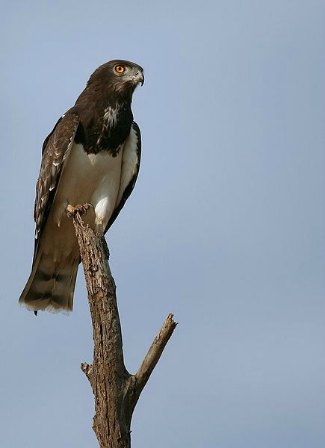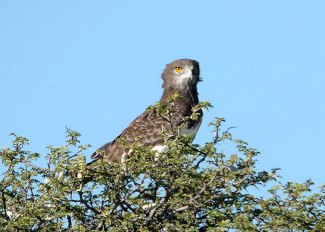Black-Chested Snake Eagle - Circaetus pectoralis
By Gaurav Pandit, CC-BY-SA-3.0, via Wikimedia Commons
Family: Accipitridae
Genus: Circaetus
Species: C. pectoralis
Black-Chested Snake Eagles are large dark brown, black, and white eagles with a range that spans from upper northern and western Africa down through the southern part of the continent. They are considered to form a superspecies with Circaetus gallicus (Short-Toed Snake Eagle) and Circaetus beaudouini (Beaudouin’s Snake Eagle). They are also part of a clade with Terathopius ecaudatus (Bateleur) and Circaetus gallicus.
Physical Description:
Black-Chested Snake Eagles have a black-brown head, shoulders, wings, back, and tail, with a white belly and underparts. The tail is barred with black, as are the secondary feathers. The beak is black and the eyes are yellow, while the cere and long, featherless legs are gray.
Juveniles are rufous and darker brown along the back. They have large brown spots on their chest which disappear when they reach full adult plumage, after approximately three years.
Black-Chested Snake Eagles are mostly silent, except during the breeding season or when around a nest. Listen to a recording.
Size:
Length: 63-68 cm
Wingspan: 178 cm
Weight: 1.2-2.3 kg
Habitat and Distribution:
They live in light woodland, savannah, plains, and other open country, including deserts.
They are found 0-3,400 meters above sea level, from 19°N to 33°S. The total distribution range is 9,690,000 km², from eastern Sudan through Ethiopia and Somalia, and across the entire continent south of the Democratic Republic of the Congo and Tanzania. They may roost together in groups of up to 200 birds during the non-breeding season, though they are mostly sedentary or nomadic.
By Brian Ralphs, CC-BY-2.0, via Wikimedia Commons
Diet and Hunting:
Black-Chested Snake Eagles eat snakes and other reptiles (such as chameleons and water monitors), rodents, amphibians, insects, small birds, bats, and fish.
They forage in flight, occasionally hovering, and drop to the ground to catch their prey.
Reproduction:
The breeding season is November-June in Ethiopia and the northern part of their range, December-October in eastern Africa, and June-January in South Africa.
The nest is 60-70 cm across and 20-25 deep. It is lined with green leaves and usually placed 3.5-7.5 meters above the ground, often on top of acacia or members of the plant genus Euphorbia. The clutch is 1 egg, and the incubation period is 51 days. Fledging takes around 90 days.
By Brian Ralphs, CC-BY-2.0, via Wikimedia Commons
Conservation:
The population trend and numbers of Black-Chested Snake Eagles are currently unknown, but because of their large range they have been listed as Least Concern by BirdLife International.
Taxonomy:
Circaetus pectoralis was considered to be a subspecies of Circaetus gallicus (Short-Toed Snake Eagle), but is now thought to form a superspecies with C. gallicus and Circaetus beaudouini (Beaudouin’s Snake Eagle). C. pectoralis, C. gallicus, and Terathopius ecaudatus (Bateleur) have been found to form a monophyletic clade based on nucleotide sequences.
Other Names:
Black-Chested Harrier-Eagle, Black-Breasted Snake Eagle, Orlík tmavoprsý (Czech), Hvidbuget Slangeørn (Danish), Zwartborstslangenarend (Dutch), Savanniköörmekotka (Finnish), Circaète à potrine noire (French), Schwarzbrust-Schlanangenadler (German), Biancone pettonero (Italian), Munagurochuuhiwashi (Japanese), Svartbrystslangeørn (Norwegian), Gadozer bialobrzuchy (Polish), Culebra Pechinegra (Spanish), Tai Kidari-cheusi (Swahili), Svartbröstad ormörn (Swedish), Xithaklongwa (Tsonga).
Video of a Black-Chested Snake Eagle:
References:
http://avibase.bsc-eoc.org/species.jsp?avibaseid=BF553D32D596A4C7
BirdLife International (2011) Species factsheet: Circaetus pectoralis. Downloaded from http://www.birdlife.org on 02/10/2011.
Global Raptor Information Network. 2011. Species account: Black-breasted Snake Eagle Circaetus pectoralis. Downloaded from
http://www.globalraptors.org on 2 Oct. 2011
BirdLife International 2009. Circaetus pectoralis. In: IUCN 2011. IUCN Red List of Threatened Species. Version 2011.1.
www.iucnredlist.org. Downloaded on 02 October 2011.
http://www.planetofbirds.com/accipitriformes-accipitridae-black-chested-snake-eagle-circaetus-pectoralis
Ferguson-Lees, James, and Christie, David A. Raptors of the World. Houghton Mifflin Company, 2001.


